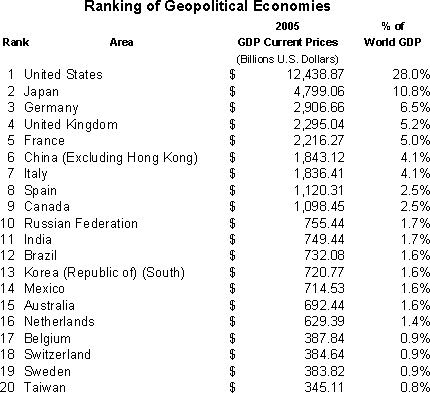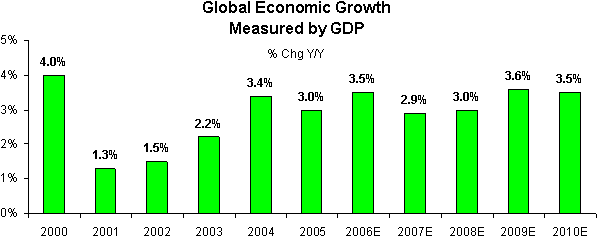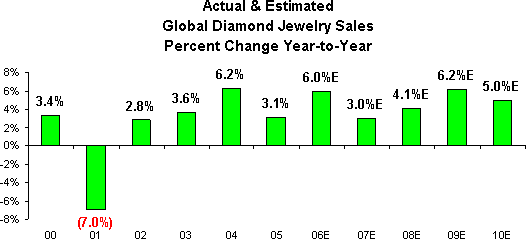IDEX Online Research Diamond Demand Forecast: Slowdown Projected for Global Diamond & Jewelry Sales in 2007
January 09, 07
A fading global economy will make 2007 a tough year for diamantaires and jewelry suppliers. Forecasters are calling for slower growth in all of the world’s major economies, including current hot spots such as China. India appears to be the only economy likely to be spared from the projected economic softness.
The good news: the pause in economic growth in 2007 should be brief. By 2008, consensus economic forecasts call for global growth to begin to recover, with continued strength into 2009 and 2010.
Jewelry and diamond demand are inextricably intertwined with the global economic cycle. When economic growth is solid, diamond and jewelry sales rise sharply. But when economic growth slows, consumers’ discretionary spending on luxury goods such as jewelry cools first and fast.
Further, diamond demand tends to lag an economic recovery by about a year. Thus, while the global economy is expected to begin its recovery in 2008, strong gains in diamond demand are expected to occur in 2009.
Projections by IDEX Online Research call for growth of diamond sales to peak in 2006, followed by slower growth in 2007 and 2008. By 2009, diamond demand is expected to recover to the robust levels that the industry experienced in 2006, as the graph below illustrates.
|
|
Global Economic Growth to Slow in 2007
While there are nearly 200 countries in the world that contribute to global Gross Domestic Product (GDP), the sum of all the goods and services produced by an economy, there are only a few that have a major impact on global economic growth. For example, the United States, with by far the largest economy in the world, generates an estimated 28 percent of global GDP. The top ten geopolitical regions of the world comprise just over 70 percent of global GDP; the top twenty geopolitical regions generate about 83 percent of the world’s GDP. The table below summarizes the impact of the world’s major economies on global GDP.

Source: Economy.com
Global Gross Domestic Product is projected to grow more slowly in 2007, with a pickup in 2008 followed by robust growth in 2009 and 2010, as the following graph illustrates.

Source: Consensus Forecasts
Global economic growth is expected to slow in 2007 due to several factors, including the following:
- Impact of U.S. economy – As the U.S. economy goes, so goes the world. The U.S. economy represents over one-fourth of global GDP. Higher interest rates, housing market weakness, and ripples from higher energy prices are all weighing heavily on the U.S. economy, and are expected to dampen economic growth in 2007.
- Impact of China – Government technocrats have said they are trying to slow China’s economic growth pace, if only to help keep global inflation down. While China is only about 4 percent of global GDP, it has both a fundamental and an emotional impact on the world’s economic growth.
- Impact of Japan – Japan is a country caught in the throes of deflation. Consumers continue to reflect melancholia, and are unwilling to boost household spending. Elsewhere, the recovery in Japan appears to be shallow. Japan’s financial institutions, including its central bank, do not appear to know what is needed to get the Japanese economy back on stable ground, despite some signs over the past 12 months that economic conditions might be improving.
- Impact of Europe – Europe’s economy has peaked, and growth will slow in 2007. Neither Germany nor France, the Euro-Zone’s two largest economies, can seem to get their economic engines revving. So far, it has been socialism over capitalism in this region; in that environment, there is no real incentive for workers to produce more.
- Impact of India – As India opens its borders to foreign investment, its economy is set to soar. Despite a global slowdown, it appears that India’s road to economic growth is well greased for the foreseeable future.
The only good news is that falling oil prices will keep consumers spending around the globe. Further, lower energy prices will also give central banks more latitude for expansionary monetary policy. Thus, the economic slowdown which is projected for 2007 may be milder than consensus forecasts.
